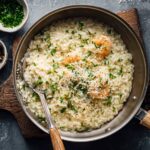Rhubarb Crumble is a timeless dessert that perfectly balances sweet and tart flavors. The tender, tangy rhubarb is sweetened just right, while the buttery crumble topping adds the perfect amount of crunch. Serve it warm with a scoop of vanilla ice cream or a drizzle of cream, and you’ve got a dessert that’s cozy, comforting, and completely satisfying.
This dish is perfect for spring, when rhubarb is in season. Its vibrant pink color and tangy flavor make it a stunning addition to any table. Plus, it’s incredibly easy to make, with just a handful of ingredients. Whether you’re serving it at a family dinner or a casual get-together, Rhubarb Crumble is sure to be a hit.
Full Recipe:
- 500g rhubarb, chopped into 3cm pieces
- 100g caster sugar
- 1 tsp vanilla extract
- 200g plain flour
- 100g butter, cold and cubed
- 100g demerara sugar
- 50g rolled oats
- 1 tsp ground cinnamon
Directions:
- Preheat oven to 180°C (350°F).
- In a large bowl, mix the rhubarb with the caster sugar and vanilla extract. Spread the mixture evenly in a baking dish.
- In another bowl, combine the flour, butter, demerara sugar, oats, and cinnamon. Use your fingertips to rub the butter into the dry ingredients until the mixture resembles breadcrumbs.
- Sprinkle the crumble mixture over the rhubarb evenly.
- Bake in the preheated oven for 35-40 minutes, or until the topping is golden brown and the rhubarb is bubbling.
- Let cool slightly before serving with cream or ice cream.
Prep Time: 10 minutes | Cooking Time: 40 minutes | Total Time: 50 minutes
Kcal: 350 kcal | Servings: 6 servings
The Ultimate Guide to Rhubarb Crumble: A Timeless Dessert Classic
Rhubarb crumble is one of those desserts that immediately conjures up images of cozy kitchens, family gatherings, and the comforting smell of home-baked goodness. It’s a dessert that holds a special place in the hearts of many, thanks to its unique balance of tartness from the rhubarb and the sweet, buttery crunch of the crumble topping. In this guide, we’ll delve into the history, variations, and health benefits of rhubarb crumble, along with tips for perfecting the recipe and making it your own.
What is Rhubarb?
Rhubarb, often mistaken for a fruit because of its use in desserts, is actually a vegetable. It has long, thick, stalks that are typically a vibrant pink to red, with large leaves that are inedible due to their toxicity. The stalks, however, are edible and renowned for their tangy, slightly sour flavor. Rhubarb is most commonly paired with sugar and used in desserts, as its natural tartness makes it a perfect match for sweet treats.
Rhubarb’s peak season runs from early spring through summer, making it a seasonal favorite for many home bakers. It’s often used in pies, tarts, and, of course, crumbles. The tartness of rhubarb contrasts beautifully with the sweetness of sugar and the richness of a buttery crumble topping, creating a dessert that is both satisfying and refreshing.
Why Rhubarb Crumble is a Classic Dessert
Rhubarb crumble has become a beloved dessert for several reasons, many of which stem from its simplicity and versatility:
- Balance of Flavors: The contrast between the tart rhubarb and the sweet crumble topping is what makes this dessert truly special. The tartness of the rhubarb cuts through the sweetness, resulting in a perfectly balanced dessert that isn’t overly rich or cloying.
- Ease of Preparation: One of the best things about rhubarb crumble is that it’s incredibly easy to make. With just a few ingredients, you can whip up a dessert that feels both indulgent and homemade. It doesn’t require any advanced baking techniques, making it accessible for even the most novice bakers.
- Versatility: While the classic recipe calls for rhubarb, this crumble can easily be adapted to include other fruits. Popular combinations include strawberry-rhubarb or apple-rhubarb, adding extra layers of flavor to the dish.
- Nostalgic Appeal: For many, rhubarb crumble is a dessert that evokes memories of childhood and family gatherings. It’s a dessert that has been passed down through generations, often served at Sunday lunches or during special occasions. The nostalgia associated with this dish makes it even more beloved.
The History of Rhubarb Crumble
Rhubarb has been cultivated for thousands of years, originally used for medicinal purposes in ancient China and Tibet. It wasn’t until the 18th century that rhubarb became popular in Europe, where it was used in both savory and sweet dishes.
Crumble, on the other hand, has a more recent history. The dessert became popular in Britain during World War II when rationing made it difficult to bake traditional pies. Flour, sugar, and fat were more readily available than pastry ingredients, so people began using these staples to create a crumbly topping for fruit. This new dessert became known as a “crumble” and has since become a staple in British cuisine.
The combination of rhubarb and crumble became a natural pairing, as rhubarb’s tartness was the perfect match for the buttery, sweet crumble topping. Since then, rhubarb crumble has become a classic dessert in Britain and beyond, cherished for its simplicity and comfort.
Variations of Rhubarb Crumble
While the classic rhubarb crumble is made with just rhubarb, sugar, and a simple crumble topping, there are countless ways to customize this dessert to suit your taste preferences. Here are some popular variations:
- Strawberry-Rhubarb Crumble: One of the most popular variations, strawberry adds a natural sweetness that complements the tartness of rhubarb. This combination also creates a visually stunning dish with vibrant red hues.
- Apple-Rhubarb Crumble: Apples add a subtle sweetness and extra texture to the crumble. This variation is perfect for those who want a slightly milder, less tangy dessert.
- Ginger Rhubarb Crumble: Adding a touch of ground ginger to the rhubarb filling or the crumble topping brings a warming spice that enhances the flavors of the rhubarb.
- Almond Crumble Topping: For added crunch and flavor, mix flaked almonds or ground almonds into the crumble topping. The nuttiness of almonds complements the tartness of the rhubarb beautifully.
- Oat Crumble Topping: To add a more rustic texture, you can replace some of the flour in the crumble topping with rolled oats. This gives the topping an extra crunch and makes the dessert feel heartier.
Tips for the Perfect Rhubarb Crumble
Making the perfect rhubarb crumble is easy, but there are a few tips and tricks that can take it from good to great:
- Sweetening the Rhubarb: Because rhubarb is naturally very tart, it’s important to sweeten it adequately. The amount of sugar you use will depend on your taste preferences and the natural sweetness of the rhubarb, but as a general rule, use around 100g of sugar for every 500g of rhubarb.
- Cutting the Rhubarb Evenly: For even cooking, make sure to cut the rhubarb into similarly sized pieces. This will ensure that the rhubarb softens at the same rate, creating a uniform texture.
- The Perfect Crumble Topping: The key to a good crumble is getting the right texture. You want the mixture to resemble coarse breadcrumbs, with some chunks of butter still visible. This ensures that the topping will be crisp and golden after baking.
- Balancing Texture: If you prefer a chunkier topping, leave some larger pieces of butter in the crumble mixture. These will melt in the oven and create a more textured, crunchy topping.
- Serving Suggestions: Rhubarb crumble is best served warm, either on its own or with a scoop of vanilla ice cream, whipped cream, or custard. The cold creaminess of the accompaniment contrasts beautifully with the warm, tart filling and crunchy topping.
Health Benefits of Rhubarb
Rhubarb is not only delicious, but it also offers a range of health benefits:
- High in Fiber: Rhubarb is an excellent source of dietary fiber, which is important for digestive health. It can help regulate bowel movements and prevent constipation.
- Low in Calories: Rhubarb is low in calories, making it a great option for those looking to enjoy a dessert without consuming too many extra calories.
- Rich in Antioxidants: Rhubarb contains several antioxidants, including anthocyanins, which are responsible for its vibrant red color. Antioxidants help protect the body from oxidative stress and may reduce the risk of chronic diseases.
- Good Source of Vitamins and Minerals: Rhubarb is a good source of vitamins K and C, as well as calcium and potassium. These nutrients support bone health, immune function, and overall well-being.
Conclusion: Why You Should Try Rhubarb Crumble
Rhubarb crumble is a dessert that brings together the best of both worlds – the tart, refreshing flavor of rhubarb and the sweet, crunchy satisfaction of a classic crumble topping. Its simplicity, ease of preparation, and versatility make it a perfect dessert for both novice and experienced bakers.
Whether you stick to the classic recipe or try one of the many variations, rhubarb crumble is a dessert that never goes out of style. It’s ideal for spring and summer when rhubarb is in season, but it can also be made year-round with frozen rhubarb.
Not only is this dessert incredibly delicious, but it also offers a range of health benefits. So the next time you’re looking for a comforting, crowd-pleasing dessert, give rhubarb crumble a try – you won’t be disappointed!





